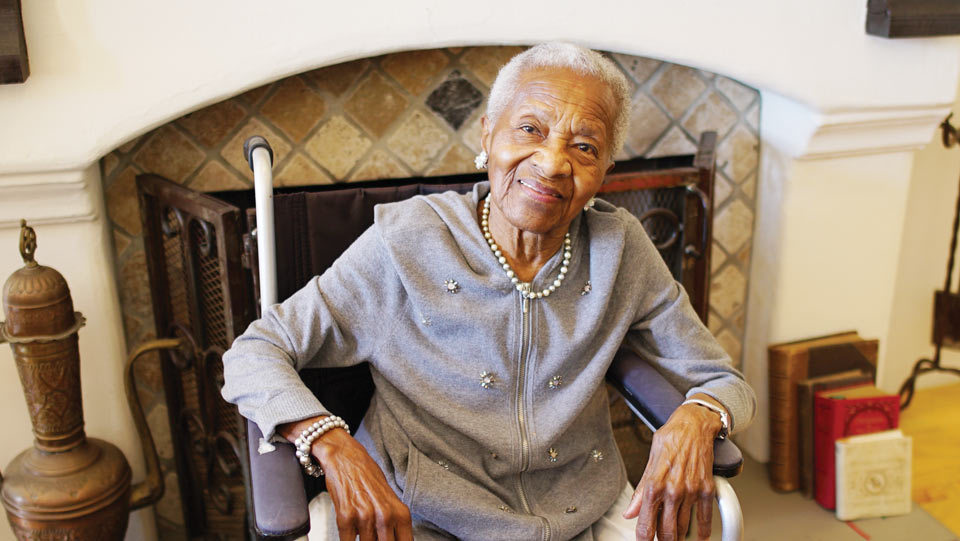Submitted photo
This undated photo of Dr. Ellamae Simmons shows her near the end of a very long life dedicated to medicine and racial integration. A committee is at work to give the Mount Vernon native a historical marker on Public Square.
Dr. Ellamae Simmons may be Mount Vernon’s most notable but least-known native citizen.
The Dr. Ellamae Simmons Memorial Committee would like to change that by placing a historical marker on Public Square dedicated to the doctor, who was born in 1918 in Mount Vernon and grew up on Pleasant Street.
Simmons’ achievements began even before she earned her doctorate of medicine, when she became the first black female physician to specialize in asthma, allergy and immunology. She was a leader in the fight for integration wherever she went, as a nurse in the US Army during World War II, as a student at The Ohio State University, and the upscale white California neighborhood where she purchased a home near Kaiser Foundation Hospital (today’s Kaiser Permanente). At the time she was hired, Simmons was only one of two black physicians on Kaiser’s staff.
“I was sitting there with my mouth open. Surely, I thought, they’ve misread the book,” Salyers said. “Maybe (Simmons) had done one of these things, but certainly not all of them.”
After graduating from Mount Vernon High School, Simmons decided to pursue a career in medicine. Her first choice was OSU, but she was turned away after being told there were no facilities to house a black woman.
Undeterred, Simmons went to Hampton Nursing School, graduating in 1940. She enrolled in the US Army nursing corps; at the time black and white servicemembers were segregated.
Simmons successfully enrolled in pre-med at OSU after the war on the G.I. Bill and was the first black woman to live in the school’s dorms. She received her medical degree from Howard University.
Racism met Simmons at every turn and yet she was able not just to overcome, but emerge with a victory for equal rights. She helped form the Kaiser African American Professional Association, or KAAPA, at Kaiser Hospital; in 1967, she purchased a home in San Francisco’s exclusive Presidio Heights, effectively integrating the neighborhood. Soon after, she became a leader in the Bay Area’s Mutual Real Estate Investment Trust, helping to secure investors to buy and resell properties in neighborhoods where homeownership by people of color was previously blocked. This began the second chapter in Simmons’ life, as a real estate investor and activist.
The committee is gathering these achievements to present to OHC, which must approve the historic marker application. A design committee has the unenviable task of telling Simmons’ story in just 230 words — the maximum amount allowed on OHC’s historical markers.
Jene Schoenfeld, who is on the design committee, said the wording has not been finalized. However, the committee has decided the marker should cover Simmons’ roles as an African American trailblazer in medicine, her military service, including the integration of the nurse’s corps, and her work to integrate neighborhoods.
“She had such a multidimensional nature,” said Schoenfeld, who teaches African American Literature at Kenyon. “In writing the text for her marker, we want to highlight the important contributions.”
Simmons passed away in 2019 at the age of 101. Research into the marker has led to the rediscovery of local connections; Simmons’ father, Augustus, had a trash hauling business that was still in operation under the Simmons name until at least the 1960s. A niece, Varian Wilson, graduated from MVHS in 1959 and went on to study medicine as well, working as a nurse in the Columbus area.
Salyers recently received a postcard from a Mount Vernon physician who shared memories of Augustus Simmons giving hay wagon rides in the fall.
Mount Vernon City Council recently approved a resolution granting space on Public Square for a historical marker dedicated to Simmons. Salyers has asked that it be placed near the veteran’s memorial, as a nod to Simmons’ service in WWII.
The committee has until Sept. 15 to file the historical marker application, but Salyers said they hope to have the paperwork completed and out to OHC by mid-July.
“I think we have a slam-dunk here, but it is up to the (Ohio) History Connection to decide,” Salyers said. “The resolution that council passed is encouraging. As a city, we’ve acknowledged that Dr. Simmons has a place on Public Square.”


